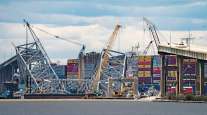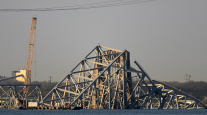Port of Baltimore Tops 10 Million Tons of Cargo for Third Straight Year

The port of Baltimore had another historic year in 2018.
The Maryland Port Administration’s public terminals handled 10.9 million tons of general cargo — more containers, cars, construction equipment and other cargo than ever before — surpassing 10 million tons for the third straight year, officials announced March 6.
“There has been no better example of Maryland being open for business than the Port of Baltimore,” Gov. Larry Hogan said in a statement. “As one of our leading economic engines, the port generates good-paying, family-supporting jobs for tens of thousands of Marylanders and will continue to create more jobs and economic benefits for our state.”
Continued growth in container and auto traffic in particular buoyed the port’s 2% increase in overall cargo from 2017, despite decreases in paper pulp and break-bulk cargo.

Port of Baltimore (Andrew Harrer/Bloomberg News)
Container traffic has shot up in recent years thanks to the opening of the expanded Panama Canal in 2016, which allowed a new generation of supersize containerships carrying goods from Asia to reach the U.S. East Coast more quickly.
In 2018, containers were both the port’s biggest source of growth and its biggest headache.
The 1.02 million industry-standard 20-foot equivalent units of containers set a record and represented a 6% increase from 2017.
But the resulting congestion at Seagirt Marine Terminal, the state-owned container terminal leased to Ports America Chesapeake under a 50-year, $1.3 billion deal with the state, has resulted in tension with the port’s union longshoremen, who were accused of walking off the job in October, and its truckers, who picketed in subfreezing temperatures in January to protest waits of up to eight hours for one load.
Autos and light trucks were up 5% from the previous year, to a record 850,147, at the port’s public and private terminals, the state said.
The state purchased Point Breeze Business Center, which it plans to convert into extra container storage space, for $55 million in 2017.

Port of Baltimore (Andrew Harrer/Bloomberg News)
The state, Ports America Chesapeake and the federal government will spend a combined $32.8 million to deepen a second container berth at Seagirt to 50 feet so the terminal can load and unload two of the massive ships at once.
And the Board of Public Works approved a plan to spend $6.3 million to pave a 7-acre wet basin at Fairfield Marine Terminal for more parking for its autos and light trucks.
Roll-on/roll-off cargo, which includes large construction, mining and farming equipment, also set a record with 565,470 imported tons.
Forestry products were a mixed bag. The public terminals handled 12% more rolled paper than the previous year but lost 63% of their pulp volume to the private Rukert Terminals Corp. in Baltimore.
“The pulp was still handled here,” port spokesman Richard Scher said.“It was just handled at a private terminal.”
The port also saw a 5% decline in break bulk, other cargo shipped outside of containers, because some of it shifted to a private Baltimore terminal, Scher said.
The number of direct jobs at the port increased by more than 12% between 2014 and 2017, according to a study by Martin Associates, a Lancaster, Pa.-based consulting firm. The average salary of a port worker is 9.5% higher than the average annual wage in Maryland, according to the U.S. Bureau of Labor Statistics.
Baltimore ranks first among U.S. ports for autos and light trucks, roll-on/roll-off heavy farm and construction machinery and imported sugar, the state said. It is second in exported coal, ninth in total dollar value of cargo and 11th in foreign cargo tonnage.
Distributed by Tribune Content Agency, LLC




